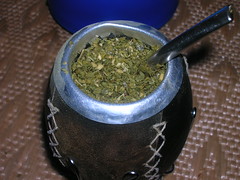The infusion called maté is prepared by steeping dry leaves (and twigs) of yerba maté in hot water, rather than in boiling water like black tea, according to Wikipedia.
It is a slightly less potent stimulant than coffee and much gentler on the stomach[citation needed]. Drinking maté with friends from a shared hollow gourd (also called a mate in Spanish, or cabaça or cuia in Portuguese) with a metal straw (a bombilla in Spanish, bomba or canudo in Portuguese) is an extremely common social practice in Argentina,[3][4] Uruguay, Paraguay, southern Chile, eastern Bolivia and Southern Region, Brazil[5] and also Syria,Lebanon and Jordan.
The flavor of brewed yerba maté is strongly vegetal, herbal, and grassy, reminiscent of some varieties of green tea. Unlike most teas, it does not become bitter and astringent when steeped for extended periods, and the leaves may be infused several times. Additionally, one can purchase flavored maté in many varieties.
In Brazil, a toasted version of maté, known as chá mate or "maté tea", is sold in teabag and loose form, and served, sweetened, in specialized shops, either hot or iced with fruit juice or milk. An iced, sweetened version of toasted maté is sold as an uncarbonated soft drink, with or without fruit flavoring. The toasted variety of maté has less of a bitter flavor and more of a spicy fragrance. It is more popular in the coastal cities of Brazil, as opposed to the far southern states where it is consumed in the traditional way (green, drunk with a silver straw from a shared gourd).
Monday, October 20, 2008
Subscribe to:
Post Comments (Atom)


No comments:
Post a Comment